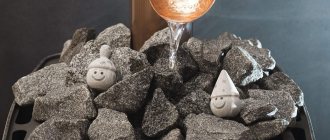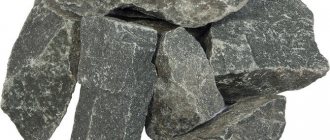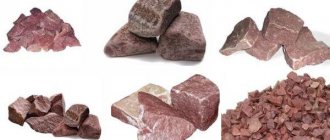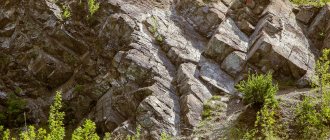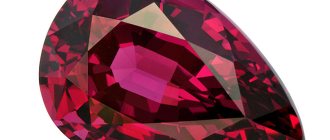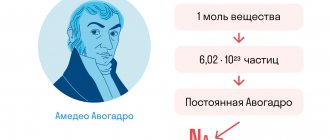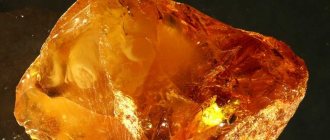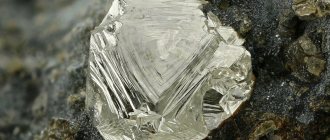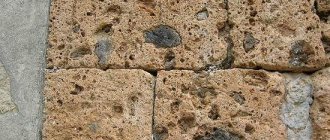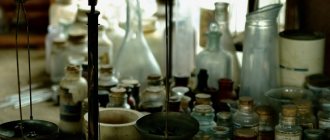Gabbro-diabase
We have made an attempt to thoroughly answer the question: what is gabbro-diabase, to consider all its properties and characteristics. The result of the work done was this section. If you don’t want to get acquainted with its subject so completely, look only at the subtitle that interests you.
What is the breed
As you can already judge from the name, this stone is a “transitional” link between diabase and gabbro. According to its characteristics, the rock is close to basalt and granite. It is a gabbro-diabase stone of a dark gray or greenish color. It contains, for example, minerals such as:
- titanomagnetite;
- plagioclase;
- pyroxenes;
- amphiboles.
None of these types of minerals release harmful substances into the air. And this is, of course, a big advantage of gabbro-diabase as a stone used in industry, construction and everyday life.
Scope of stone application
Gabbrodolerite is widely used:
- In road construction. Stone is used to make checkers, paving stones, curbs, and to strengthen slopes, ditch walls, trays, and to pave squares, sidewalks, and public gardens. The material is resistant to abrasion and mechanical stress.
- In civil engineering it is used as plinth stone and rubble. Polished and heat-treated tiles are produced from gabbro-diabase for decorative cladding. Interior decoration includes the creation of staircase steps, railings, window sills, bathrooms and kitchens.
- For sauna stoves. Due to the fact that natural material heats up perfectly, first accumulating heat and then releasing it, gabbro-diabase is used in the construction of baths and saunas.
- In landscape design of parks, public gardens, personal plots. Black oblique boulders and cobblestones are laid on green lawns or included in colorful alpine slides.
Part of the gabbro is used for the production of crushed stone of various fractions, which is produced using modern technologies and is widely used in industrial, civil and road construction.
Gabbrodolerite is a durable stone of natural origin with visual appeal. The qualities of gabbro allow this mineral to be used in various fields. Diabase stones are used for paving streets and squares. Red Square in Moscow and the lobby of the Chernaya Rechka metro station in St. Petersburg are paved with Karelian rock. In what other areas is this mineral used? The fossil is also used:
- in architecture as an independent material or base stone;
- in the production of crushed stone, rubble;
- in the manufacture of decorative items (sculptures, engravings);
- in the production of tombstones;
- in precision engineering;
- in heaters of bathhouse or sauna stoves.
The amulet, made of gabbro material, gives its owner physical endurance and performance. This stone exhibits its magical properties only in strong-willed, active, purposeful people. It will not be of any use to weak and uninitiated individuals. At the same time, the owner of the amulet must believe in its power.
Where can it be used?
According to sanitary and hygienic standards, gabbro-diabase stone is one of the rocks permitted for use in construction with background radiation not exceeding permissible standards. This material is used quite widely in industry.
One of the features of gabbro-diabase is its interesting fine-grained structure. This stone is polished better than, for example, granite and basalt. Therefore, it is sometimes used as a facing material in the construction of buildings and structures. This breed can also be used:
- for the manufacture of paving stones (for example, exactly this material was used on Red Square in Moscow);
- in precision engineering.
Very often, tombstones are made from such stone. Polished black gabbro-diabase looks very solid and presentable. Therefore, tombstones made from it, like no other, create an appropriate mournful and solemn atmosphere at the burial site. For the manufacture of monuments, Karelian diabase is usually used, which can maintain polish for a long time.
Very often this breed is used to create optimal temperature conditions in baths. That is, they simply put these inexpensive stones in the heaters. Dense gabbro-diabase can retain heat very well and for a long time. In addition, the material is absolutely environmentally friendly.
Like granite, gabbro-diabase is often used in the interiors of apartments and houses. This material is used, for example, to make countertops, railings and window sills. Such products actually look very impressive. In addition, they also have very good performance characteristics.
Production
On our website there are articles that are devoted to the extraction of gabbro-diabase - this is material about the deposits (with addresses) and an article about the extraction and processing of this stone.
You may also be interested in materials about a variety of products that are made from it (including monuments) and what can replace gabbro-diabase in a bathhouse, in construction or in the manufacture of a monument.
Physical properties of the rock
The properties of gabbro-diabase, among other things, are distinguished by the following:
- High degree of density - 3.07 g/cm3.
- Compressive strength - 311 MPa.
- Low degree of abrasion - 0.07 g/cm2.
This stone is also characterized by frost resistance. Gabbro-diabase tolerates temperature changes well. The breed can withstand up to 300 cycles of temperature fluctuations without harm. The radioactivity of this material is up to 74 becquerel/kg. In terms of strength, this type of diabase surpasses even granite.
Varieties of diorite, their differences and appearance
There are many types of diorite. The rock is divided into varieties depending on various characteristics: structure, chemical and mineral composition, and the presence of quartz. Many subspecies can be distinguished from others by external characteristics. The widest groups of diorites are quartz and non-quartz.
Descriptions of these and other varieties of rock are presented in the table.
| Sign | View | a brief description of |
| Quartz percentage | Quartz-free | Quartz content: less than 5%. |
| Quartz | Quartz in the rock occupies from 5 to 20%. Quartz diorite is light in color. | |
| Structure | Uneven-grained | They differ in the size of inclusions and their location. Coarse-grained specimens are less durable. |
| Porphyriform | ||
| Coarse-grained | ||
| Fine grain | ||
| Chemical composition | Hornblende | The rock contains a significant amount of hornblende. The stones are dark in color. |
| Mica | One of the main rock-forming minerals is mica, which gives diorite a brown tint. | |
| Augite | The basis of the breed is augite. Samples with its inclusions acquire a dark green tint. | |
| Mineral composition | Orthopyroxene | They differ in the structure of the crystal lattice of the pyroxenes included in the composition. |
| Clinopyroxene | ||
| Bipyroxene | ||
| Kersantite | Refers to mica diorites. It has a fine-grained structure and dark color. | |
| Diorium porphyrite | The inclusion grains are large and unevenly located. The color is gray with a green tint, and may have a brown-red color. |
Previously, tonalite was classified as diorite. However, it contains more than 20% quartz substances, so it was isolated as a separate species. Gabbro diorite, banatite, andesite-diorite are also distinguished. Gabbro diorites are characterized by a dark gray, almost black color. Gabbro has a medium-grained or coarse-grained structure. Andesites have milky tones.
How to mine
Development of gabbro-diabase deposits can be carried out using a variety of technologies. Most often, to extract this material, a hole is first drilled into the rock. Further into it to break the stone can:
- planting explosives;
- pump air under pressure;
- water is supplied and wooden pegs are hammered in (which, swelling, tear the stone).
Gabbro-diabase can also be divided into pieces using, of course, a stone cutter. This technology is currently considered the most expensive and labor-intensive. But at the same time, using it you can extract the highest quality stone.
The unique Karelian gabbro-diabase is currently considered the best in the world. And the deposit itself in this region is one of the largest in the world. The reserves of this type of diabase in Karelia are no less than 4 million m3.
Australian stone is also considered a fairly high-quality material. Its properties are close to Karelian. However, this breed, unfortunately, is much more expensive. The price of Australian diabase is almost three times higher than Karelian diabase.
Description and features of the stone
Gabbro-diabase is considered a holocrystalline, fine-grained volcanic rock. The name of the stone comes from the word “glaber” from the Latin language and means “smooth”. The composition of the rock is close to basalt, however, it has a low silica content. The proportion of mineral does not exceed 52%. The rock has a diabase (ophite) structure, formed by long plagioclase crystals placed in a chaotic order and augite in the gaps. Gabbro-diabase is included in the list of natural stones.
The crystal lattice gives the material strength, moisture and frost resistance. The rock is not destroyed by heat and sudden changes in temperature, and has a low degree of radioactivity. High hardness reduces the likelihood of diabase abrasion over centuries. It is difficult to split the rock; processing is carried out with special equipment using labor-intensive technological processes. The compressive strength grade of gabbro-diabase is 1400 kg per square cm.
Stones have properties beneficial to human health. A visit to a sauna using diabase has a beneficial effect on the nervous system, relaxes, and gives strength. The breed affects the functioning of the genitourinary organs, improves the condition of the kidneys and liver. Stones stimulate the cardiovascular system. Massage balls are made from gabbro-diabase to relieve stress when used.
Astrologers endow the breed with magnetic power. It is believed that the stone brings improved relationships between family members and strengthens attachment to home. Diabases are used to make amulets in the form of rings and pendants for the neck.
Species and production of the breed
The main characteristics when classifying varieties of gabbro-diabase are the origin, properties, and composition of materials. Diabases are divided into groups depending on the proportion and composition of impurities, level of hardness, and endurance.
Based on the presence of minerals in the rock structure, the following types of gabbro-diabase are distinguished:
- quartz;
- olivine;
- calcite;
- enstatite;
- biotite;
- limonite.
The composition of a substance determines its quality. Separation of diabases based on the presence or absence of elements in the structure is necessary to identify the characteristics of the material.
Based on their composition, the breed is divided into the following groups:
- olivine;
- ordinary;
- quartz;
- olivine-free;
- leukophyres (modified diabases);
- Saussurian;
- low-colite;
- mica.
Large-scale mining of gabbro-diabase is carried out in four regions: China, Australia, the Crimean Peninsula, and the Onega region. Australian and Chinese breeds are of the highest quality. The third place is occupied by durable, heat-intensive Karelian stones. Crimean material is purchased cheaply due to the large amount of iron in the composition. Impurities affect the hardness of gabbro-diabase and its ability to retain and release heat.
Negative aspects of diabase
The stones are not suitable for regular use due to their fragility. Constant work with the material leads to the destruction of the rock. A third of diabase crumbles in the first year of use. The strongest substance completely disintegrates within four years. When gabbro-diabase crumbles, sulfur is released that is toxic to humans, so the stone that has begun to deteriorate must be replaced for safety reasons.
The material does not withstand open fire. Drops of essential oil eat into the structure of the diabase, are not washed off and remain on the surface of the stone.
Gabbro-diabase for baths: reviews
In everyday life, this stone is most often used in steam rooms. Reviews from bathhouse owners about this breed are mostly positive. The shape of gabbro-diabase is flattened. Therefore, it is very easy to install it in the heater. At the same time, such stones can retain heat for quite a long time.
Bathhouse owners believe that some of the disadvantages of gabbro-diabase are that after prolonged use it begins to crumble. However, this disadvantage is observed in all stones used in steam rooms. Sauna stoves have to be cleaned when using any rocks. Meanwhile, diabase is cheaper than many other breeds intended for steam rooms. Therefore, bathhouse owners do not incur any extra costs when using it in heaters.
When heated very strongly, judging by reviews, this breed is capable of emitting a characteristic odor. But most bathhouse owners do not consider this a disadvantage of stone. The smell, judging by the reviews, of gabbro-diabase is not unpleasant or harmful.
According to the owners of suburban areas, this breed has only two main disadvantages. Firstly, when using a stone in a steam room, you cannot use essential oils. Such substances leave indelible marks on gabbro-diabase. It is also highly recommended not to allow stones of this variety to come into contact with open fire. Because of this, their service life is significantly reduced.
Selection rules
When choosing gabbro-diabase for use in a heater, pay attention to the following key points:
- At the fracture, the structure should be as fine-crystalline as possible. Large grains indicate low strength, and such a specimen will quickly collapse when heated.
- Examine the structure using a magnifying glass for microcracks. When heated, they will begin to rapidly increase in size until the stone turns into dust.
- The body of the mineral should not contain a large number of inclusions of quartz. If this is observed, you are offered not gabbro-diabase, but some other rock.
- When struck, the stone should respond with a clear, transparent and elastic sound. A dull, annoying echo indicates the presence of hidden defects in the thickness.
- Form. In a closed heater, rounded stones will behave better, because there is always a little space between them, enough for water to flow inside. In the open, split gabbro-diabase is preferred for more dense installation.
- Many varieties of gabbro-diabase contain increased amounts of sulfides. Visually, they look like a scattering of small crystals with a mirror-like silvery or less often golden sheen. When heated, sulfides will break down and release a pungent odor, which will cause a sore throat and stinging in the eyes. The decomposition of sulfides can take quite a long time, so such a stone should be discarded.
- To test for strength, knock 2 stones together or hit them with a hammer. There is another indicative way to check the suitability of a stone. Heat it until red hot and immediately plunge it into cold water. If cracks or splits do not appear, you can safely use the stone in steam rooms and baths.
- Availability of a certificate. You should not collect any stones yourself in unverified places, near railways or in close proximity to industrial facilities. The stone tends to absorb various microparticles and odors, which can subsequently affect the quality of the supplied steam, and in some cases even pose a health hazard.
For your information! Domestic varieties of gabbro-diabase fully meet the basic requirements of a bath attendant and at the same time have an affordable price. The purchase of a more expensive Finnish stone is justified only by a better selection of stone and the absence of harmful sulfites in its array, which is often the case with Karelian analogues.
How much is the breed worth?
If desired, you can purchase this stone for a bath at any time from any company specializing in the supply and installation of stove equipment. Gabbro-diabase is usually sold by weight - in kilograms, packaged in boxes. The cost of stone from different suppliers may vary. However, most often this breed is sold for no more than 250-300 rubles. for 20 kg.
Mining locations
Large deposits of the mineral are noted in three main regions: Crimea, Australia and the Russian Onega region. The cheapest is Ukrainian gabbro-diabase. The Crimean breed contains a large amount of iron impurities, which reduces the quality of raw materials. Australian and Russian stones are almost identical in composition, but their overseas counterpart has a very high cost.
The Karelian mineral is distinguished by its deep, rich black color, aesthetic appearance and reliable resistance to aggressive external environments. Indicative characteristics significantly distinguish Russian gabbro-diabase from the rest.
Reviews from numerous customers confirm not only the practical durability and reliability of the natural material, but also the unique property of accumulating and preserving heat. The optimal ratio of quality and cost makes Karelian stone the most in demand not only in the post-Soviet space, but throughout the world.
Comparison with granite
The two breeds have similar physical characteristics. Sometimes gabbro-diabase is even considered a type of granite. However, this is, of course, not at all true. These two breeds differ in the following characteristics.
- By origin. Gabbro-diabase is a volcanic rock. It is found quite rarely on our planet. Granite is formed at great depths under the pressure of the upper layers. This stone has a layered structure.
- By appearance. Granite is characterized by a huge variety of colors. Gabbro-diabase, unfortunately, is inferior to it in this regard.
- According to physical properties. Granite is harder than diabase. But at the same time it is not so durable. In addition, diabase is significantly superior to granite in terms of wear resistance.
Gabbro-diabase has a unique structure - completely crystalline, which makes it practically impenetrable to water. It is this rock that has the lowest percentage of moisture absorption among all known on the planet.
Application area
Gabbrodolerite is a durable stone of natural origin with visual appeal. The qualities of gabbro allow this mineral to be used in various fields. Diabase stones are used for paving streets and squares. Red Square in Moscow and the lobby of the Chernaya Rechka metro station in St. Petersburg are paved with Karelian rock. In what other areas is this mineral used? The fossil is also used:
- in architecture as an independent material or base stone;
- in the production of crushed stone, rubble;
- in the manufacture of decorative items (sculptures, engravings);
- in the production of tombstones;
- in precision engineering;
- in heaters of bathhouse or sauna stoves.
Gabbrodolerite has medicinal properties. The stone has a positive effect on the genitourinary system, improves liver function and stabilizes the state of mind. Smooth, unprocessed minerals are used in stone therapy when heated. There are some contraindications to this procedure, so you should consult your doctor before undergoing it.
The amulet, made of gabbro material, gives its owner physical endurance and performance. This stone exhibits its magical properties only in strong-willed, active, purposeful people. It will not be of any use to weak and uninitiated individuals. At the same time, the owner of the amulet must believe in its power.
Properties and uses of stone
Diorite belongs to the group of minerals - granitoids, belongs to rocks of medium composition and has a nominal alkalinity range.
Physicochemical characteristics:
- hardness – 9 points on the Mohs scale;
- rock density limit (compressive strength) – 150–280 MPa;
- structure – full-crystalline (can be either fine-grained or coarse-grained; a fine-grained structure is more valuable);
- texture – homogeneous;
- cleavage – absent;
- shine – oily;
- additional properties - heat resistance, resistance to mechanical damage, the ability to not dissolve in acid, not to absorb moisture.
The main areas of application of stone are related to its physical properties. Due to its high strength, the mineral is used:
- for the manufacture of countertops, sinks, fireplace surrounds, stairs and building facades;
- added to concrete and asphalt mixtures for greater wear resistance;
- in landscape design;
- for the manufacture of decorative items (vases, floor lamps, sculptures).
